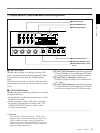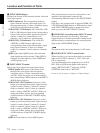
Features
Chapter 1 Overview
6 Chapter 1 Overview
A Wealth of Interfaces
Digital interfaces
The unit provides the following two digital interfaces.
• SDTI (QSDI)
1)
: This interface enables SDTI (QSDI)-
format video, audio and time code signals to be
transferred between this unit and the Sony EditStation
either at normal speed or four times normal.
• AES/EBU interface: This interface enables AES/
EBU-format digital audio signals to be input and
output.
As an option, you can also use the SDI (Serial Digital
Interface) as an interface for D1 (component) format
digital video and audio signals.
Analog interfaces
The unit also comes with analog interfaces enabling it
to be connected to analog video and audio equipment.
• Analog video: These interfaces include a component
interface, composite interface, and S-video interface.
• Analog audio: 4-channel input and 4-channel output
are both provided.
Facilities for High-efficiency
Editing
The unit provides an abundance of functions that
enhance editing efficiency and precision.
High-speed transfer of digital signals
Using the QSDI interface enables the digital video,
audio and time code signals to be transferred between
this unit and the Sony EditStation ES-7 at four times
the normal speed.
Supports ClipLink function
In response to commands sent from the EditStation,
index pictures that are recorded on tape or ClipLink
log data that is recorded in the cassette memory can be
transferred to the EditStation. The EditStation
operator can then efficiently use these pictures and
data in a preliminary editing session.
For more information about the ClipLink function, refer to
the “ClipLink Guide” also supplied with this unit.
Internal time code generator/reader
The unit contains a time code generator/reader which
can generate and read longitudinal time code (LTC) in
the SMPTE format (DSR-85) or EBU format (DSR-
85P), to ensure frame-accurate editing.
When the unit is equipped with an optional DSBK-
130/130P Time Code Input/Output Board, it can
output the time code read from tape as analog (LTC)
signal, and receive externally generated time code
(LTC).
Remote control
The unit can be operated by remote control from an
editing controller that supports the RS-422A interface
or from a SIRCS
2)
-system remote controller such as the
optional DSRM-10 or SVRM-100A.
High-speed search function
The unit has a picture search function that allows you
to view color picture at playback speeds up to 32 times
normal speed in forward and reverse directions.
When remote-controlling this unit in shuttle mode
from an editing controller or a remote controller, you
can search at any speed in the range 0 (still) to 32
times normal in both directions. You can also search
frame-by-frame in jog mode.
At search speeds up to 2 times normal, you can also
hear playback audio.
........................................................................................................................................................................................................
1) QSDI is a type of SDTI.
SDTI is the name of a standard interface established as
SMPTE 305M.
This unit uses SDTI to transmit DV data, and the input/
output connectors are labeled “SDTI(QSDI)”.
In indicator and menu indications, however, the
“SDTI(QSDI)” name is shortened to “QSDI”.
In the remainder of this manual, the short form
(“QSDI”) is used.
2) SIRCS (Sony Integrated Remote Control System)
A command protocol to remote control Sony
professional videocassette recorders/players.


















